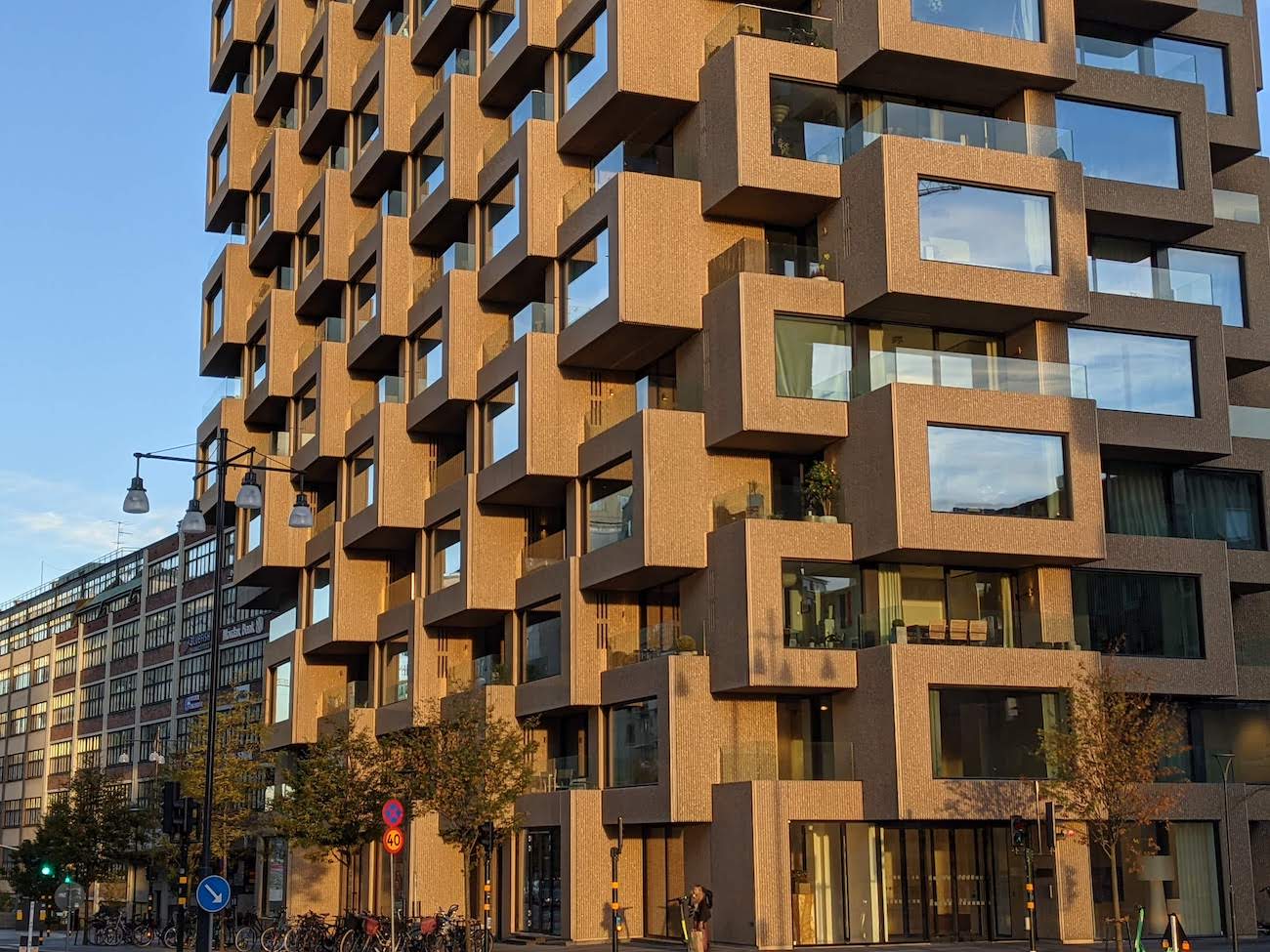STOCKHOLM SKY
It's been 4 years that I've lived in Stockholm. I moved from Fortaleza in Brazil, also called 'The land of light', known for its beaches and good weather.
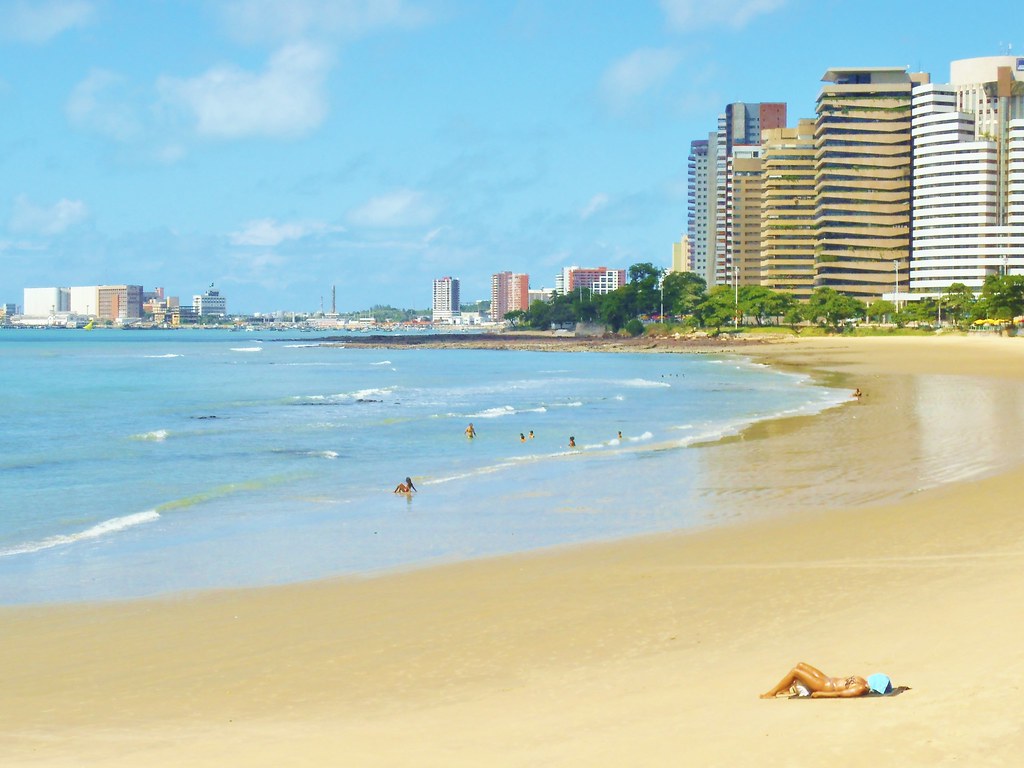
Photo by Benevaldo Lima.
The sky looks like that the vast majority of the year, it rains very little, the temperature goes from 24°C to 32°C, and the days have basically the same length throughout the year. What I took for granted seems to be the Swedish dream.
I intentionally didn't read anything about Sweden before moving here. I didn't want to be affected by others' perception of society. My thought was that I wanted to go through the experience of building my own. I read about the US before moving there and I feel that it affected, not always in a positive way, how I perceived and interacted with Americans. All I knew about Sweden was the university that I was about to study at.
I had never been to Europe before and I didn't expect that I would want to live in Stockholm. Little by little I started to consider that possibility. I knew my studies would go by fast and I felt I wouldn't have much time to decide about staying. I then started to spontaneously interview people who have been living here for most of their lives, both young and retired, Swedes and foreigners. Most of them looked happy, but I can't remember anyone who didn't express something negative about the weather. Typically, they said: "there's too little sun here", "it's too dark", "the winter is way too long", "I'll never get used to this". It always sounded exaggerated to me, but it wasn't so uncommon to hear people saying that the weather and depression are related. Their expressions when talking about the weather were typically of frustration, disgust, sadness, or comedy, which I believe is a natural strategy to cope with tricky situations. I could not understand how the sky could influence them so much.
Soon I met Stockholm's winter for the first time. The two photos below were taken at the same place:
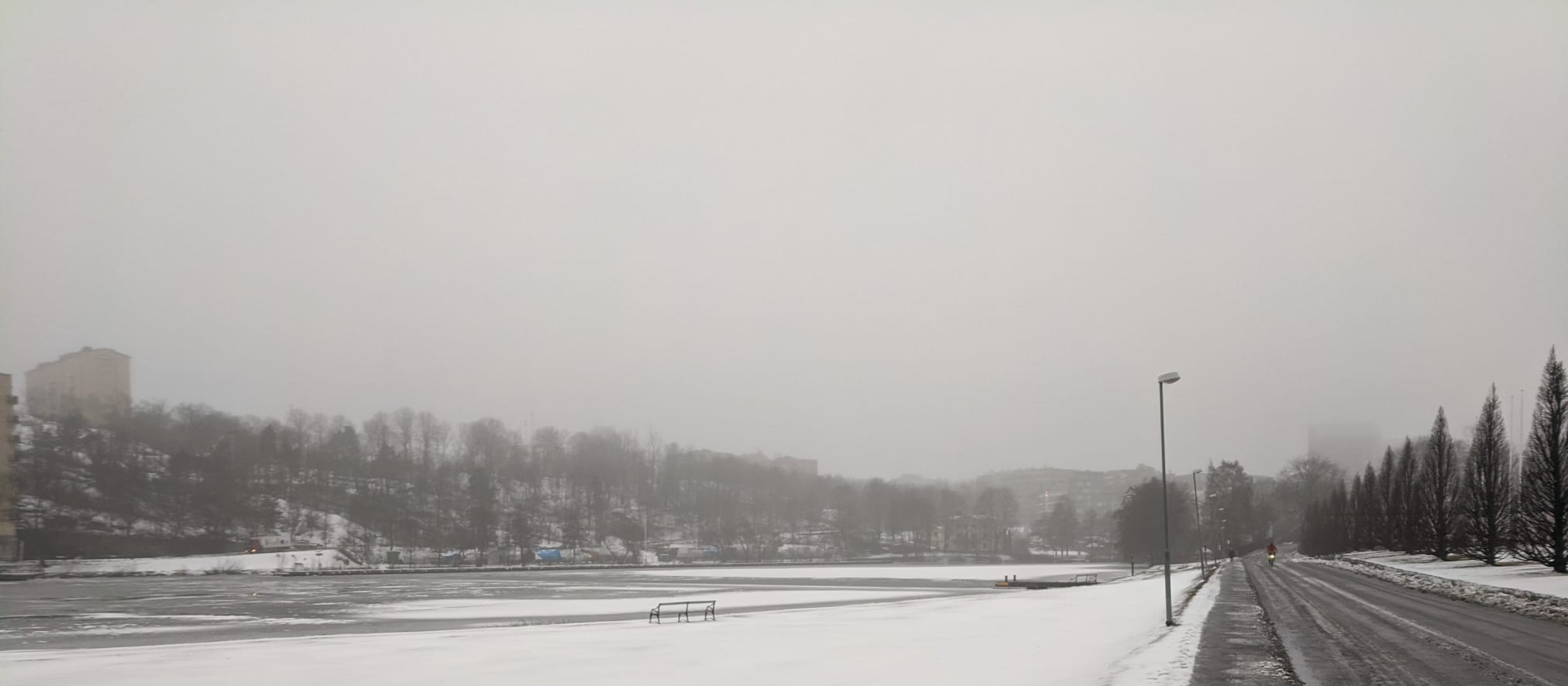
This is not a black and white photo. At Karlbergs Slott, Stockholm - 12 March 2021.
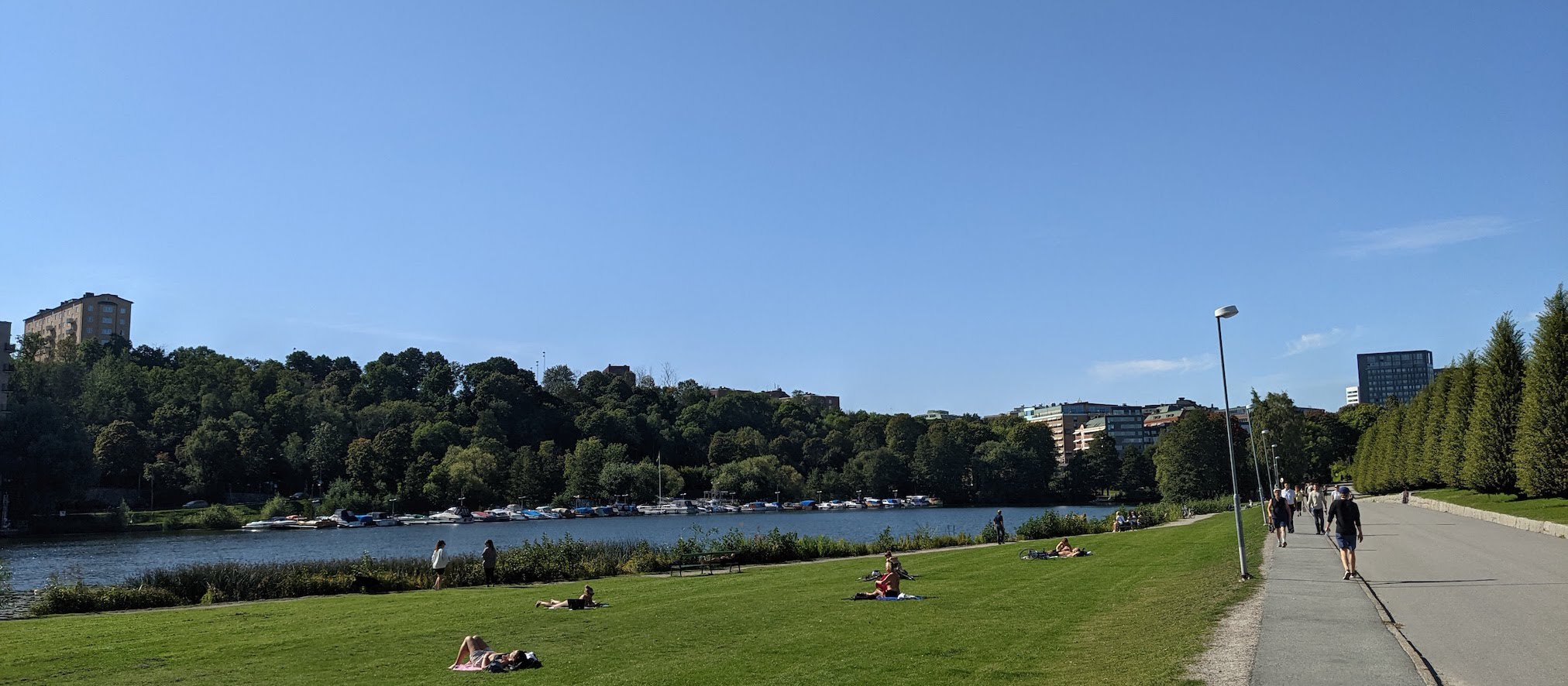
At Karlbergs Slott, Stockholm - 5 September 2021.
Before you continue reading, please answer the two questions below fast (using more of your emotions and not so much of your brain). If you haven't lived in Stockholm, just type 0 and press continue.
But soon the winter was over and the spring was there. Sure I understood it was cold, but I didn't feel I could relate to the same negative feelings I believe others have about the winter. It didn't snow everyday. It was still possible to bike for a decent part of the winter. I didn't feel I suffered even without boots and a proper winter jacket.
People then said: "The cold isn't really the issue, the problem is the darkness. The lack of sun. Vitamin-D. Short days. You go to work it's dark, you come back home and it's already night. You feel tired. You just want to sleep. You can still do things but it's typically harder and your motivation is lower". Then I started to create a bit more empathy for the issue. The problem isn't the temperature as I thought, but the gray weather.
I still couldn't relate to that in the same way, but certain things started to get my attention:
- Traveling seems to have become a basic need here and it's nice to emphasize on social media that you are not in Stockholm's weather.
- The weather can be used as a provoking tool.
- Blue sky, just as alcohol, tends to help people interact here.
- Indoors Vs Outdoors.
- Aesthetics have another level of importance here.
- Horizontal city.
- Girls won't admit, but the size of your balcony does matter.
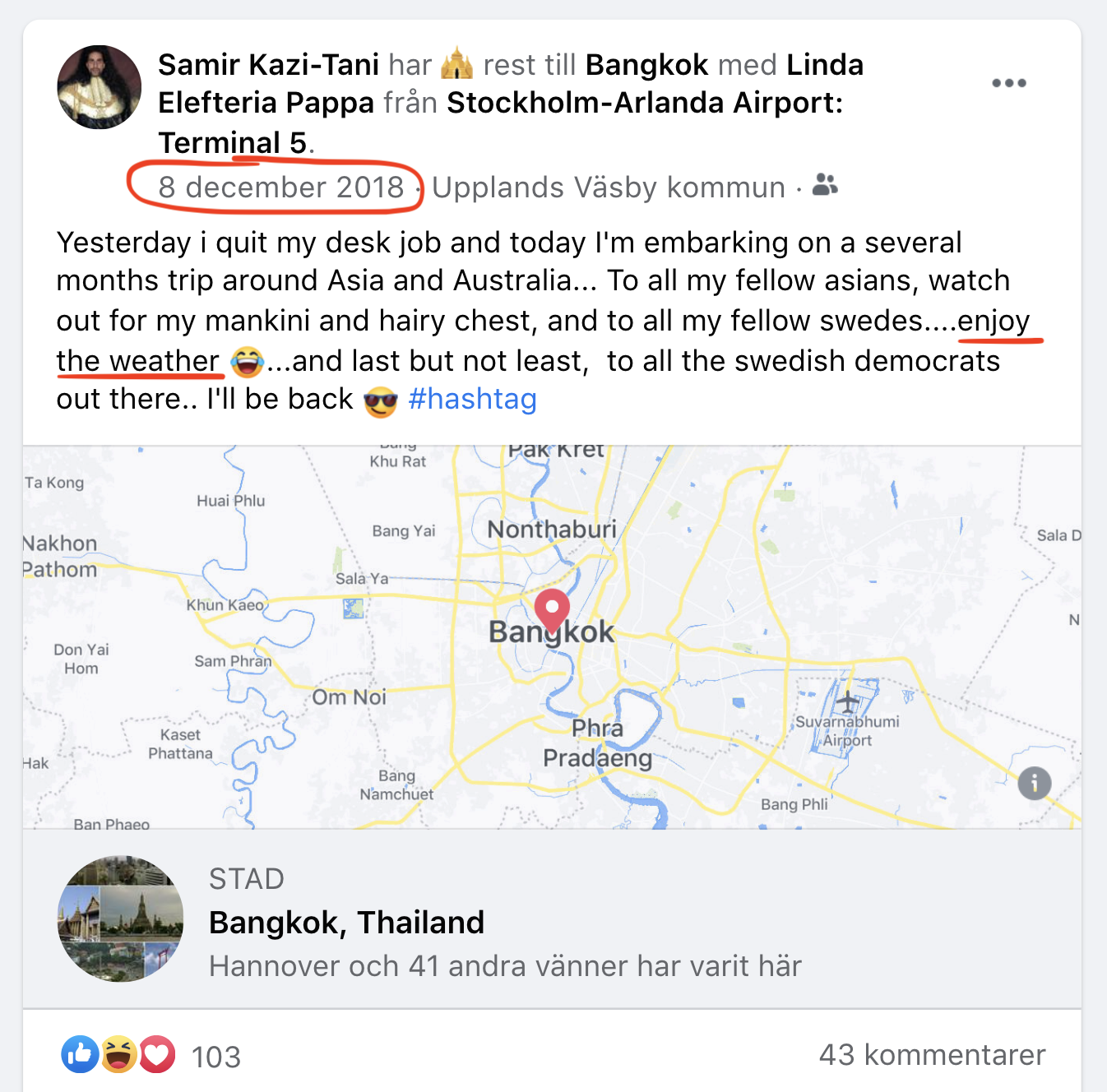
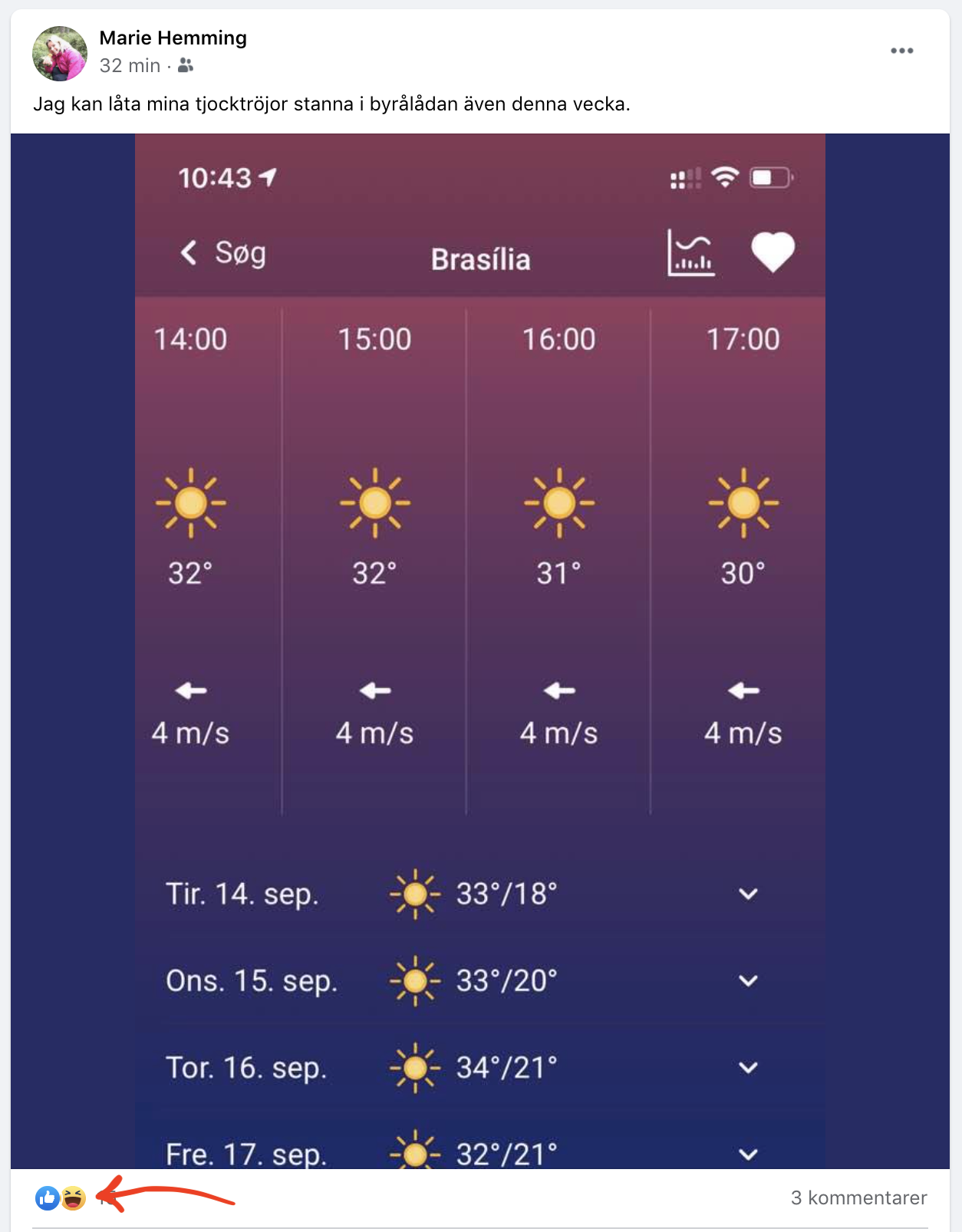
My friend Samir left his job in the middle of the winter and it was important for him to send his message to his fellows. Marie moved to Brazil and wanted to share the fact that she could leave her thick sweaters in the closet that week.
It was insane for me how often Stockholmers travel. Some come back from a trip and a few months later start to plan the next one. It feels like traveling got to a point that if they don't do it they will feel something is missing. The routine in the city is completely different during summer, which is when most people take their vacation. You make sure you book your dentist, doctor, or whatever appointment you need before June because you know you might not be able to count with them during the summer. They'll probably be traveling in a warmer country. Institutions will have different opening hours if not closed. If you stay in the city the whole summer you might eventually feel that, even though the city is much more alive, your social circle is quite fragmented since most people are traveling in different weeks. I also kinda feel that there is a little disappointment in the air when I'm asked what my plans for the summer are and I say that I'll see when it arrives. Not traveling might possibly sound as if your life is not interesting or not going that well. I would take the risk of saying that more than 50% of Brazilians never went abroad. Most people who did it, did that once or twice in their lifetime, for like 15 days, and that's it. Here people seem to have developed an urge to travel. It isn't strange to see people traveling 1, 2, or even 3 times per year by airplane. My friend's dog here has been in more countries than I have. It feels like travelling is a (needed?) national hobby.
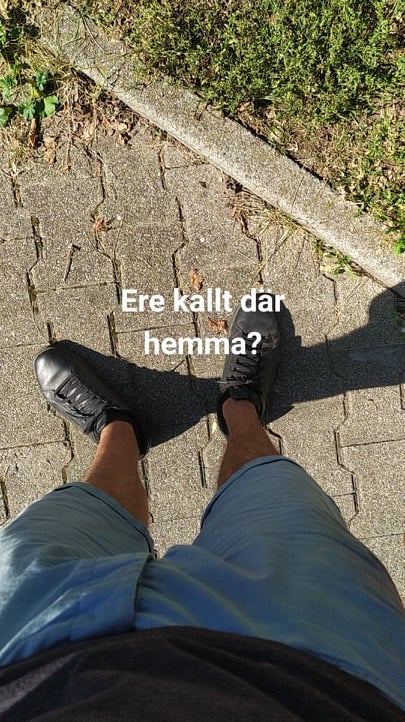
Christian, born and raised in Stockholm, joking with the fact that he could still wear shorts in Germany in September. He asks "Is it cold over there?". Samir replies back in english so I could be included. Dankey, the owner of the dark hole, is Christian's dog.
Samir sending his kind midsummer greetings to his friends in Sweden.
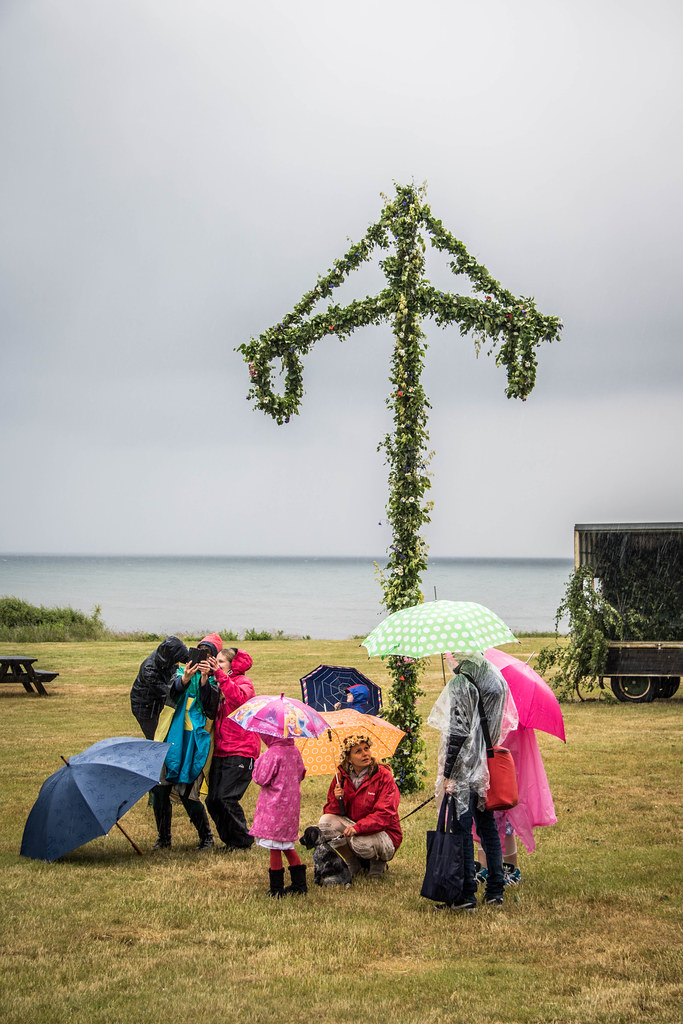
Midsummer. Photo by Susanne Nilsson.
Sure Samir is an exaggerated personification of himself, but I feel that it says something about Stockholm, where he was born and raised. Everybody expects clear weather in midsummer. It's one of the most important festive dates in Sweden. Everybody wants to be out in their summer houses, but it usually ends up raining and that sort of became a joke.
Still in Fortaleza, I met my friend Aline who had just returned from a one year trip in Europe. She lived mostly in the Netherlands. Back then, Europe was as monetarily distant for me as any other planet. She was one of the very few close people I knew who had stepped over this continent. When talking about Dutch, she said: "...they really say: Wow, what a beautiful day!", just because the sky was mostly blue. We laughed about that. For me, that was a phrase said only in the movies. I can't remember hearing that phrase in Fortaleza at all. I can't even remember checking the weather forecast there. But it's true, people tend to look happier and more prone to interact here when the sky is blue.
A very common complaint, both from Swedes and foreigners, is that it's not easy to spontaneously start a conversation with people on the streets. When you are in nature, however, the contact with people seems to be easier. The more isolated the woods are, the easier the contact seems to be, at least superficially (what sometimes might be tricky/awkward even between neighbors). People from far away might wave their hands or, when passing each other, say "Hej hej :)". There are several words/greetings that I think sound quite nice and friendly: Hej! (Hi), Tjena! (What's up?), Tack så mycket! (Thank you very much!), Kram (hug), Puss (kiss). There is, however, one modality of using them which is quite common. Repeating them twice and saying sharply fast: Hej hej! Tjena tjena! Tack tack! Kram kram! Puss puss! For the speed, imagine a master chef cutting a carrot with a sharp knife in 3 pieces with a smile on her face. Tack tack! I'll never be able to fully understand and feel the Swedish language and its intonation as someone who born here, but the impression I get when someone uses the "double-fast" greeting version is that the person is "showing that he/she is nice and polite" but wants to finish the interaction right there. In many situations, things are done in a way that there's not much room for a conversation to emerge. I'm typically more prone to try a conversation if I get a “Heeeeej” instead of a “hej hej”. A “Tjeeenare!" instead of a “Tjena tjena”, or a “Nämen tack så myyycket!” instead of a “Tack tack!”.
I would have to write several pages to try to express why I think new interactions here can, in many cases, be so fragile and difficult to move from nice, polite, and casual to honestly close and including. The point though is that it seems that during sunny days people perceive reality a bit differently. It seems as if it's perceived as an exception, and therefore their behavior doesn't seem to be "business as usual" anymore. The boring side of the city (bureaucratic services) is pretty much shut down during summer. On clear days, people go to the parks, they swim in the rivers and ocean, they party outside and they seem to be more prone to interact with strangers. I feel people look more into each other's eyes during those days. You might get a smile here and there, and it might happen that someone starts talking to you even in the city with an opening sentence about the weather.
The winter is quite cold. It requires proper infrastructure in the houses to isolate the temperature, which on its hand also ends up helping isolate the sound. In Fortaleza, without an open window you'll probably find it very uncomfortable to sleep due to the heat. During the day, a typical house will absolutely always have their windows opened. You are therefore never really completely isolated from the city. You are typically always hearing something from outside and/or feeling the wind/heat. You are hardly ever completely "indoors".
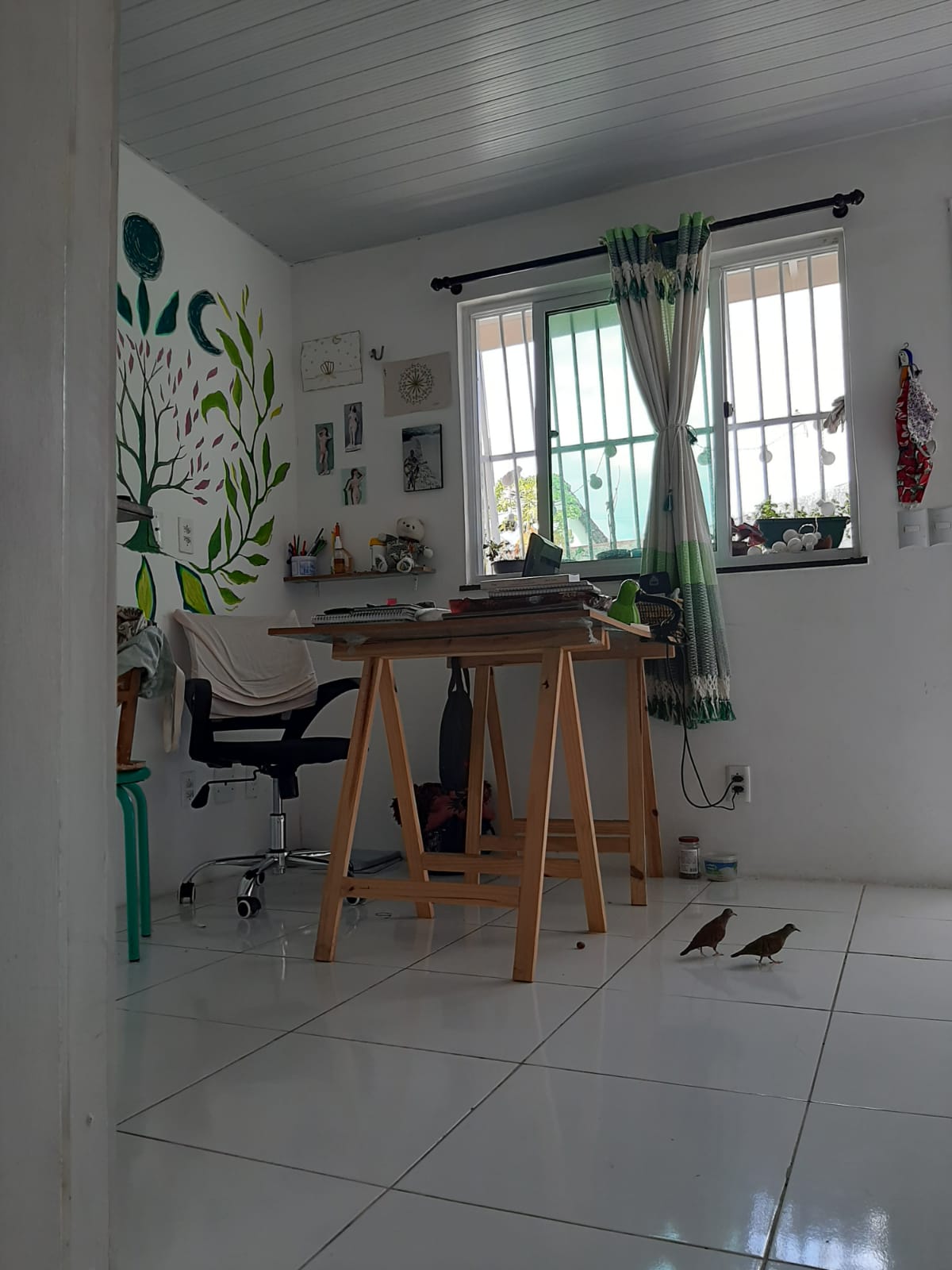
My friend's bedroom with a thin window opened. Two birds decided to enter and explore the area. Photo by Aline Rodrigues.
I wasn't friends with one of my neighbors in Brazil. They were a family of 5 members. We never spoke for more than 3 minutes. I know, however, when the kid brought his girlfriend home one of the first times. I know when they broke up and what the girl said to him. I know that the father spent only one new year's eve with his parents throughout his whole life. I know that "baixinha" was the intimate nickname he gave to his wife. I know what time they started cooking lunch because I could hear the dynamics in their kitchen. I know that one of the kids was not doing well at school. I heard that all. If I missed something because I was out, the parrot that they had as a pet would repeat the key words from 5:00 am to 5:00 pm.
I don't know anything intimate about the neighbors I had in Stockholm so far. It wasn't possible to hear much. I thought I would become friends with one of them but we sort of stopped talking when he complained about my loud music. I think he was probably right. It was loud and late in the night. Still, if you have lived in Stockholm enough time it's very likely that you have heard stories about neighbors complaining about (what in many countries would be considered) mild things. Things such as using a vacuum cleaner, a few hairs falling into someone's balcony, music, someone singing, etc. That might be enough for quickly canceling a possible friendship. My friend Marita once got a complaint from his downstairs neighbor saying that her flip-flop was too loud. She then decided to add rubber under them. I saw her flip-flops and I swear to you that it was not a horseshoe made out of metal. It was just an average flip-flop.
The feeling I have when I'm indoors here is different from the indoors in Fortaleza. It feels more private, silent, calmer, cleaner, and isolated here. When we feel different, we tend to act differently, and if it happens enough times, that ends up shaping us. Generally speaking, it seems to me that Stockholmers tend to be calmer people, very sensitive to sound and visual pollution. Kids here are much calmer and well behaved. Even the dogs are super chill. The noise level in the busiest parts of the city is still quite low. People typically speak with very calm voices, sometimes murmuring, when in public spaces. A collective agreement for the silence. It might feel sometimes as if people think that they are in a library.
Since day one I could feel that design was something special here. It took me a while to even find where to put my hands to get soap at the Airport's toilet. Everything was super white and too minimalistic for what I was used to. The vast majority of the houses that I have been in were super beautiful inside. It sometimes felt as if I was in an interior design magazine. In Fortaleza, only rich friends could have that standard (for the whole family), but here young adults, sometimes even students, already have their own well designed and furnished apartments. I was surprised to see so many young people living by the standards of a well established adult and saying "my apartment...".
Neusa, the woman who ended up becoming my mother here, was a key person to direct and indirectly open my eyes to some traces of the Swedish culture. She loves Sweden. She once said to me that it's important that the house feels nice inside to compensate the "ugly" weather outside, since people might have to stay inside for much longer during the winters when comparing to other countries. In fact, it didn't take that long for me to feel that an apartment here means much more than just the place where you live. It might feel sometimes as a showroom. A place where the high taste of the owner can be exhibit to the visitors. It's not even uncommon that you get a tour/presentation of the apartment when you visit someone for the first time.
It's delicate to assume that the reason why Stockholmers are good at interior design is due to the weather. It's difficult to isolate that from other factors such as how much money people have and how much free time they have to spend on that. Yet, I wouldn't be surprised if the weather has indeed, since the early days, been a strong contributing factor for creating a culture concerned with the aesthetic of things. It seems to me that most Stockholmers have a "natural" concern for aesthetics which end up shaping a skill. You can feel that just by seeing how people dress here for banal situations. It feels as if everybody has taken a basic fashion course.
During my first days at school I was 100% sure that some people there were going to work after class, or going to a job interview, or possibly to a formal ceremony (baptism, funeral, wedding, etc). After a few weeks I understood that they were just going to watch a few classes, have lunch, and go back home. If I went to my university in Fortaleza dressed 50% as well as they were here, people would most likely ask the reason why I was doing that. In Fortaleza's weather anything more than a T-shirt, pants, and sneakers will make you sweat. I had to update the concept of “simple” in my brain from “cheap - not so carefully thought” to something closer to “fashionable - not so cheap - few elements preferably in plain colors - carefully thought but looking casual/natural”. It also seems that minimalism has been associated not only with having few things that serve a purpose, but few things that serve a purpose with style, otherwise you might just look like a sloppy person who doesn't care about your items and uses the same clothes every day.
When it comes to indoor gatherings, being mysig here seems to be higher up in the importance list than being fun(ny) and memorable. Things seem to be perceived as nice here when the food is very beautifully set on the table, the space is not completely full, and everything feels predictable and under control. Then people are satisfied. Many girls say: “Aahhh, det var sååå mysigt. Tack för inbjudan :)” with an emotional face. It feels like they are all in love with each other.
Although there seems to be a housing shortage in Stockholm (prices are getting crazily high), there are not so many tall buildings here. They typically go to a maximum of 6 floors. Even though most tall building proposals are most likely refused by Skönhetsrådet (Stockholm's Beauty Council), which aims to preserve the cityscapes, the NIMBY (Not In My Back Yard) phenomenon might also be a reason for that. It might feel disrespectful to create shadows in the city here. Imagine how you would feel during the winters if someone simply decided to put a huge cardboard box right in front of your window, blocking the few hours of sunshine you used to have.
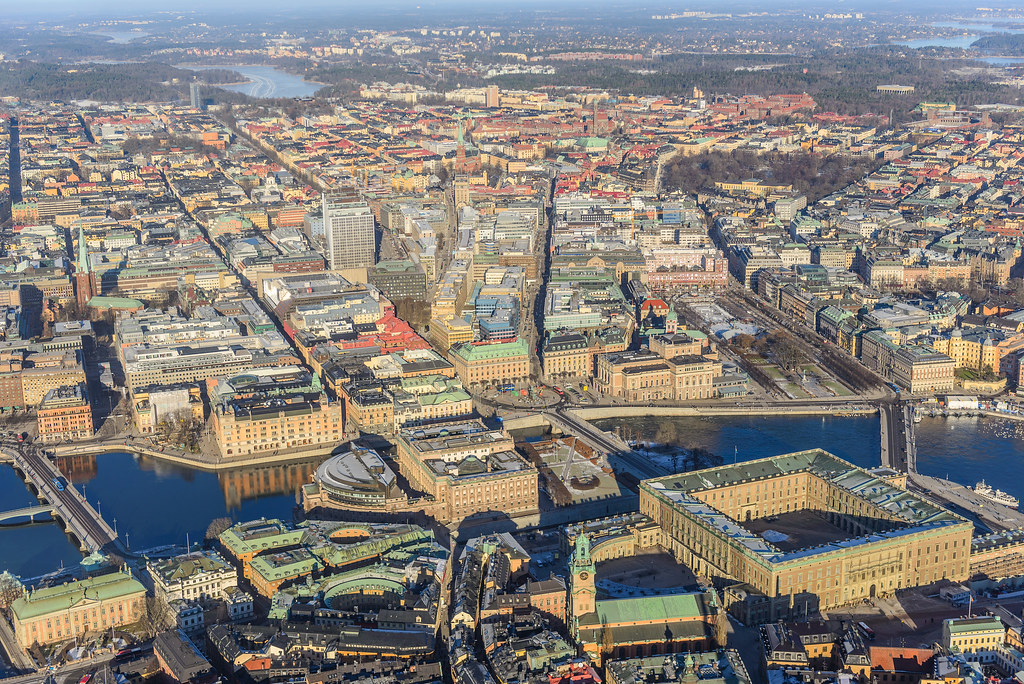
Photo by Arild Vågen.
In my brain, a balcony has always been related to something relaxing and/or fun, but here it seems to be on a completely different level. It's much closer to gold.
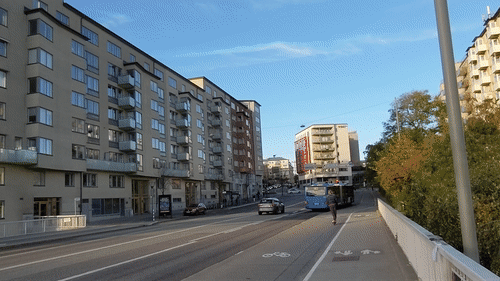
Now I understand better the value of a big balcony. It's sometimes not only the most adored part of the apartment but it also has a social power. They talk about the balcony and might show pictures on their phones with the last plants that they bought to put there. People seem to somehow be proud of their balconies. A big victory to have got an apartment in the middle of the city with a few square meters under the sun for a few hours. It will attract people to hang out there. Some people are even building whole apartments as a big balcony box covered by glasses so the light can get in.
It was getting clear that the weather affects people here from many different angles, but the fact that they were always complaining about it started to bother me. It felt as if they were saying that 80% of the year is horrible. That sounded unrealistic and too pessimistic. I was naturally trying to argue against it, but I probably sounded like a pretentious kid. You can't compare the experience of going through 1 winter with someone who has gone through 30, 50, or 70. I had no experience here when compared to them. It was time to look into the data.
Under normal conditions, the sky is blue if we aren't in a sunset/sunrise. Between us and the so desired soul-lifting sun, the biggest enemy are the clouds:

Photo taken from spacespot.
We can say that, regardless whether it's winter or summer, if we have a sky covered by clouds, the day is gray and you might also need to be prepared for rain or snow. If the sky has few clouds, it might still be freezing cold, but the day is blue and beautiful and you'll be able to feel the sun right on your face. Too many clouds -> great chance people will be complaining. Few clouds -> great chance people will be content.
Swedes seem to like numbers, especially when it comes to apartments. How many rooms does your apartment have? How many square meters? How much did it cost? How much is the rent? How long does it take you to get to the city? They are indeed insanely good at storing data. Sweden was the very first nation to keep track of their population's data. "Together with Finland, Sweden is the only country that has continuous information about its population so far back in time". With the clouds it wouldn't be different, they seem to be as important as the population. Stockholm has, since 1756, someone in charge of going out every single day to a specific spot of the city, look up to the sky, and estimate the percentage of clouds. Nowadays this is done automatically by ceilometers.
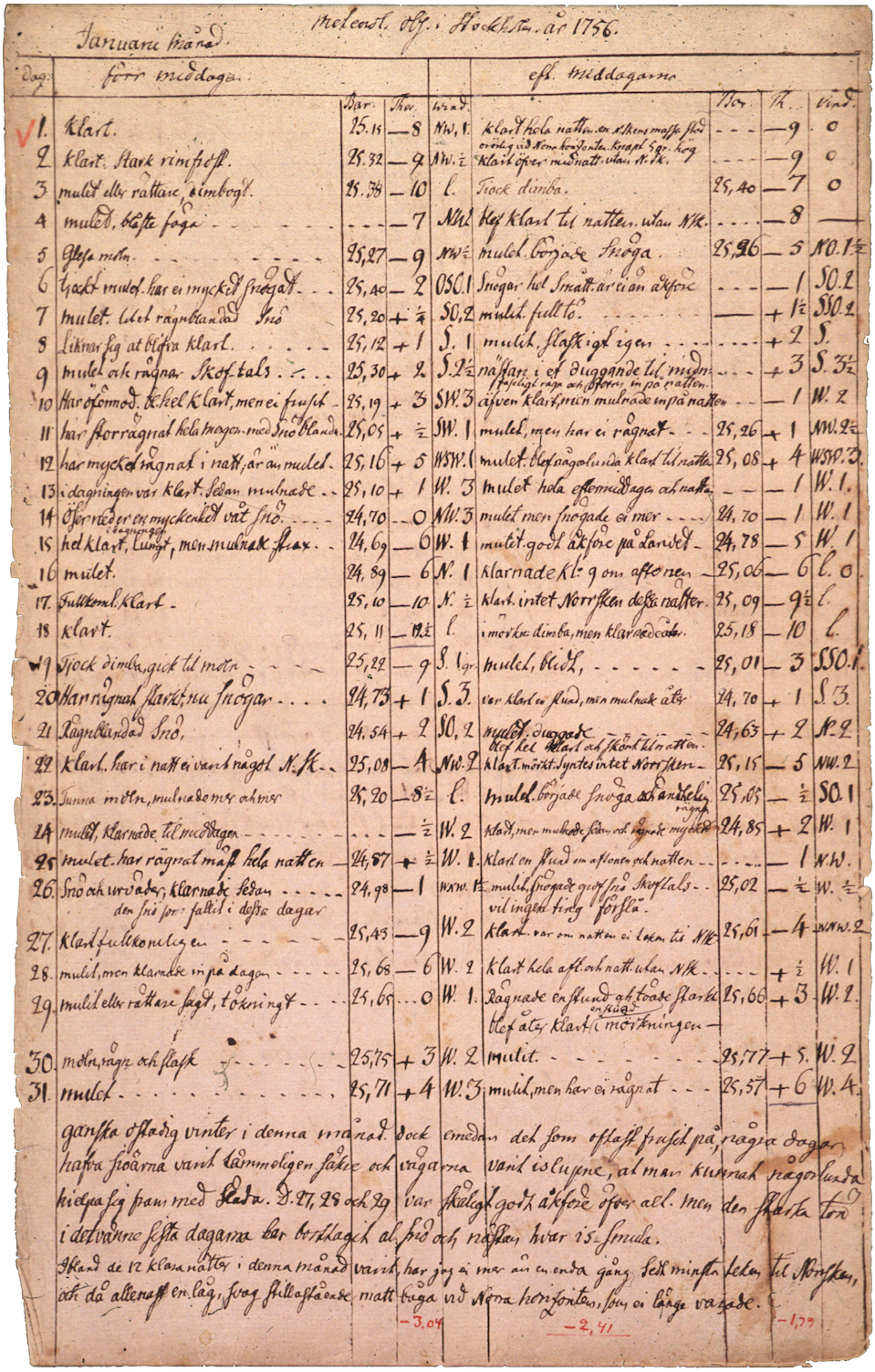
Weather observation diary of the astronomer Pehr Wilhelm Wargentin, January 1756.
I decided to use that data as an indicator of how blue and gray a day is. Data from 1756 to 2018. A total of 262 years. Fortaleza is 295 years old. Sounds like a decent amount of data. The original documents are kept by SMHI and part of it was treated by Anders Moberg, who was extremely patient in explaining to me everything through emails [Thanks Anders!]. The data can be accessed here. I've also contacted SMHI a few times and asked whether they have a database with photos of the sky for the past years so I could use them to represent that data. Unfortunately they said that there wasn't any.
I've then decided to start taking one photo of the sky everyday for one year between 12:00 and 12:30 pm:
I have now 365 photos of the sky. The vast majority was taken from this spot in Vasastan in Stockholm. The photos cover a full cycle of the earth around the sun. Summer, spring, winter, and fall. I've been posting them on this Instagram account:
With those photos and the cloud database, I made this webpage where you can see how the sky looked at midday (how much cloud) on any day from 1756 to 2018. It's nice that you can filter the year to show only sunny or overcast days. We can then have a clear view of how many days in the year are gray and how many days you'll be able to go out with your friends without complaining that the day is so gray and depressing.
Earlier you wrote on this page that you perceive the year in Stockholm as:
% Clear
% Overcast
Here's how a typical year looks like over here:
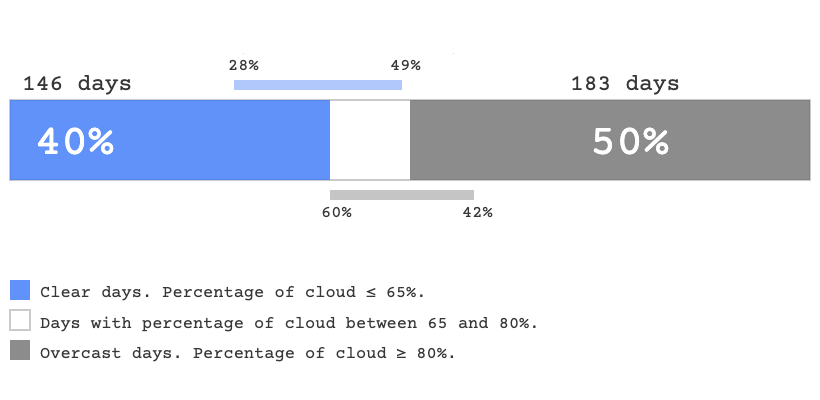
Data analyzed from 1961 to 2018 for the sky at 12:00PM.
During the year that I spent taking the photos, I counted 169 clear days and 158 overcast days.

One photo of the sky everyday for a year. From 1/jun/2021 to 31/may/2022.

I counted 169 clear days and 158 overcast days.
We can't say that it's our dreams graphic, but for sure it's not the worst nightmare either. For me, it actually enforces how great the city and the people living here are. If there weren't extremely positive points on having a life here to compensate for the effects of the weather, people would be fighting to leave Stockholm. That's not what I see in practice. I see people returning from their overseas adventure to try to (re)build their lives here. I think most people here are actually quite aware of that, but in the same way that I used to take the sun for granted in Fortaleza, I feel that many here take Stockholm's positive sides for granted:
A lot of nature 10 minutes away from basically anywhere in the city; Allemansrätten; Clean water that you can swim in everywhere; Very low social inequality; Extremely safe city (how many times a stranger pointed a gun or knife at you or your mother because this person wanted your mobile phone? How many times does this thought go through your mind per week? How many times have you bought something cheaper because you know there's the risk that someone will simply take it from you? How many times you went by taxi instead of using public transport just because you needed to bring your laptop with you?); Great career possibilities; Cultural diversity (large number of migrants who are in their second or third generation and who work in all areas of society. From entertainment to the person who is going to make a surgery in your daughter's brain); Higher gender equality than most countries; Beautiful cityscapes that can be part of your typical days and not only in a postal card or Instagram; Gorgeous archipelago; Not prohibitively expensive (you will have the means to a decent life if you have a low paying job. You don't need to pay 60% of your salary with housing if you manage to get into the system. You'll probably travel abroad at least once a year if you want); Free education (you actually get paid to study. All Swedes studying at University level receive around 4000 sek per month if studying full time); Almost free healthcare system (you pay the price of 1 or 2 pizzas to see a doctor. If you have bought 10 pizzas in a year, your next visits will be free. If you get cancer you'll be fully covered); Financial security (today, October 2021, if you lost your job you can receive 6400 sek/month (grundbelopp) until you get a new job + complementary insurance (inkomstförsäkring) for few months which is based on how much you made last year + possibility of receiving housing allowance (bostadsbidrag). It's not a lot, but it will be enough if you are a young adult without a family); Great housing infrastructure (do you have problems sleeping because it's too cold or too hot inside home? Do you drink water straight from the tap? How often cockroaches and rats show up inside your home in the middle of the night?); Bike friendly (for sure there's always room for improvements, but if you believe Stockholm is not good enough to bike maybe you haven't had to compete for space in a daily basis with buses 60 cm away from you, nor have walked through Lisbon's hills); Parental benefits (mother and father can each stay at home for one year without working and receive 80% of their salary + 3 months receiving 3600 sek/month. This is probably one of the best countries to raise a family); ...
PS: The city is amazing but for sure it might take a few years for refugees, new comers, and other underprivileged groups to be able to be part and fully enjoy it.
If you can't feel that the scarcity of some of these “invisible” elements can affect you as much as, or even more than, the scarcity of sun, you have probably not gone through long periods without them. I wouldn't be surprised if there are as few places on earth with those qualities as there are places with Fortaleza’s weather.
